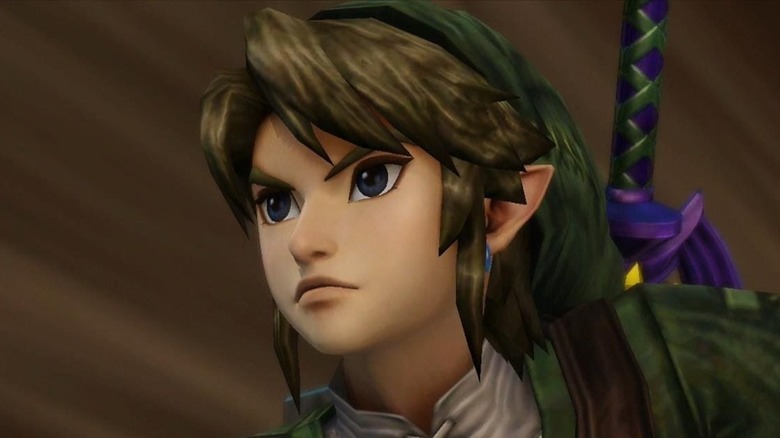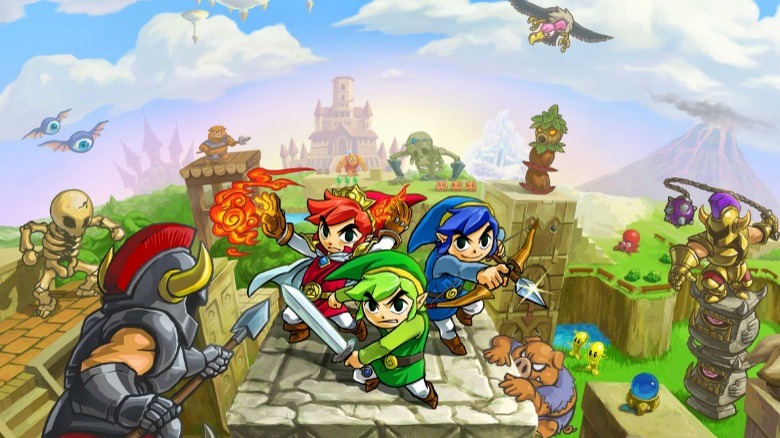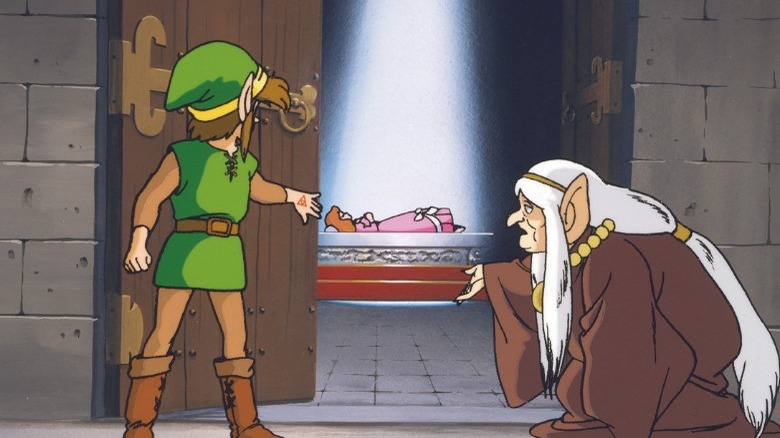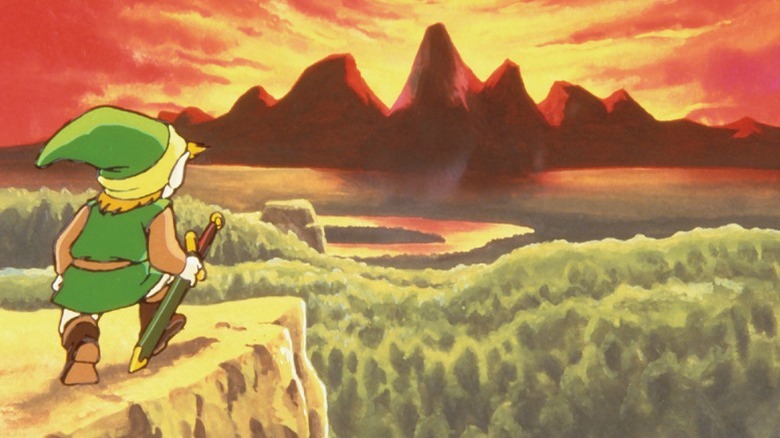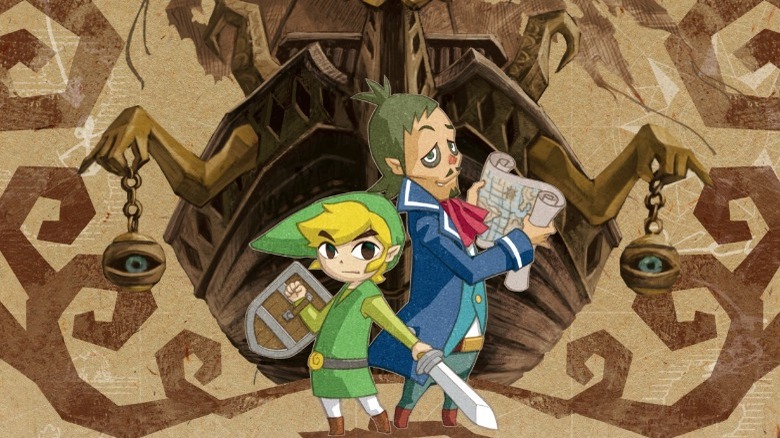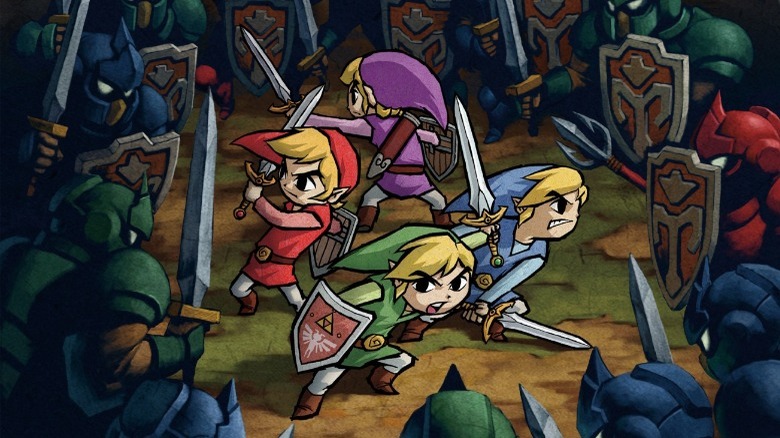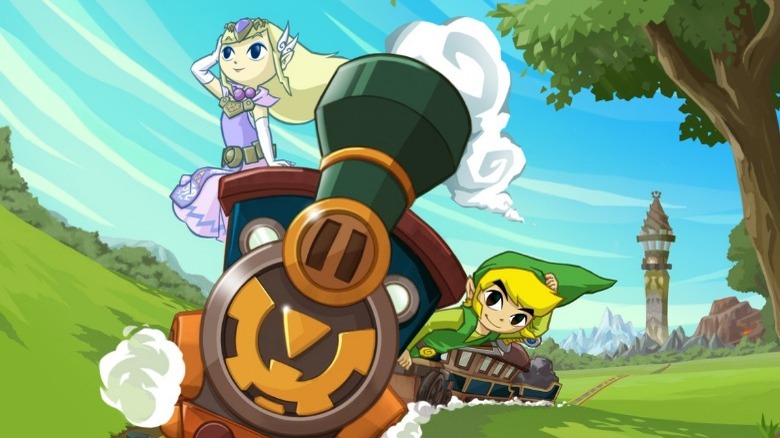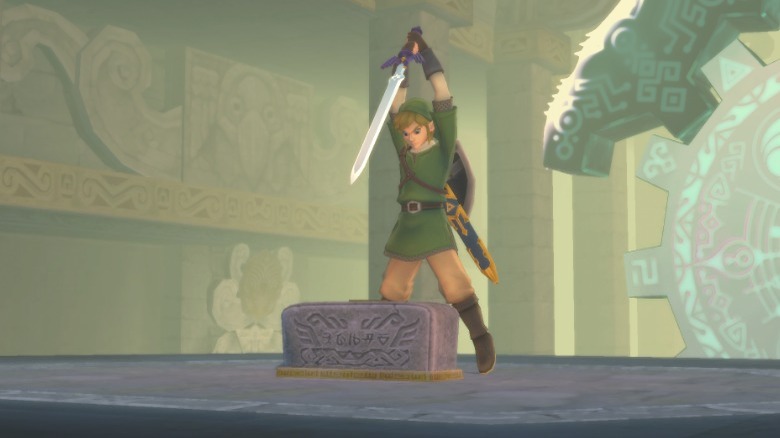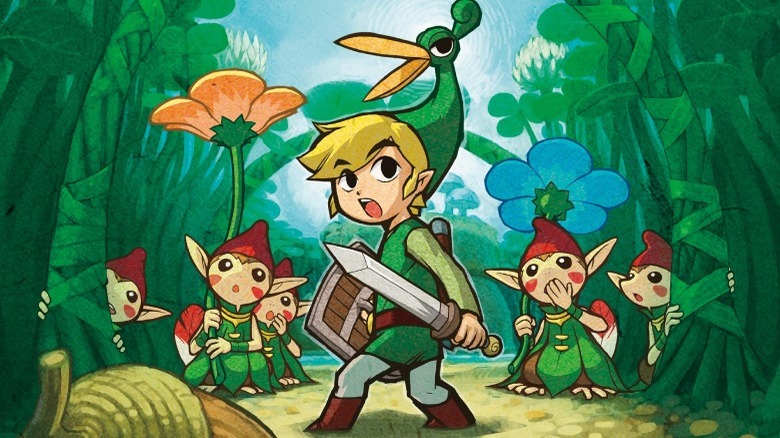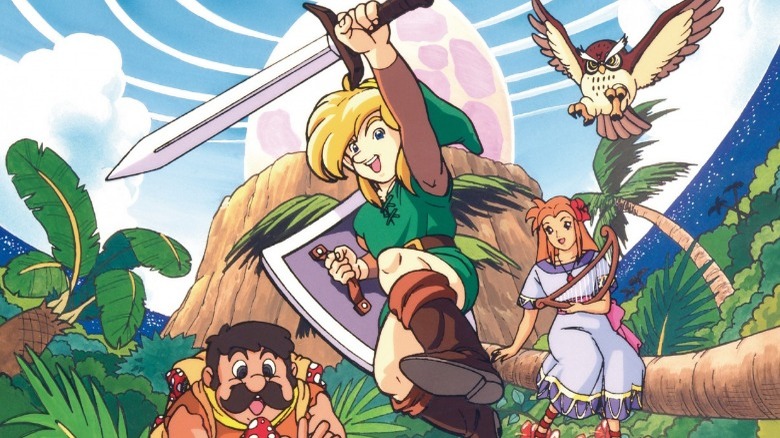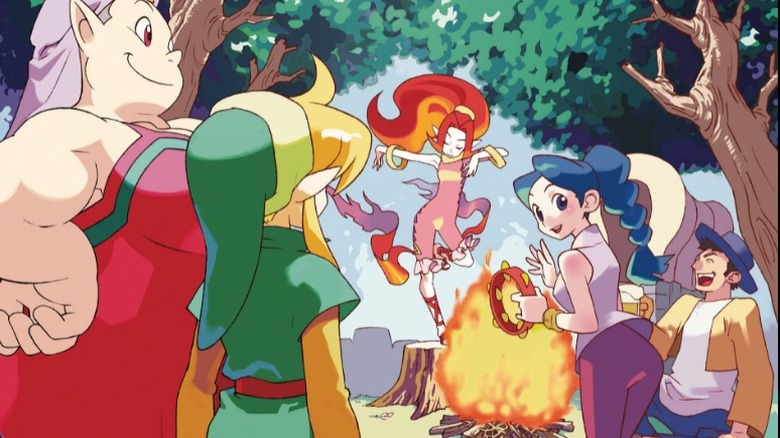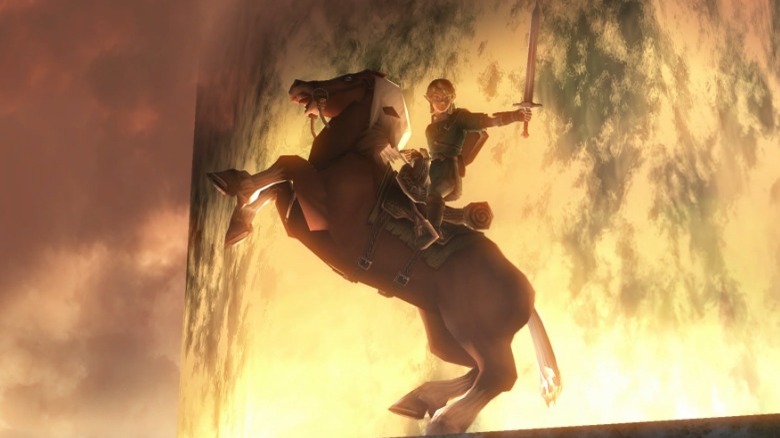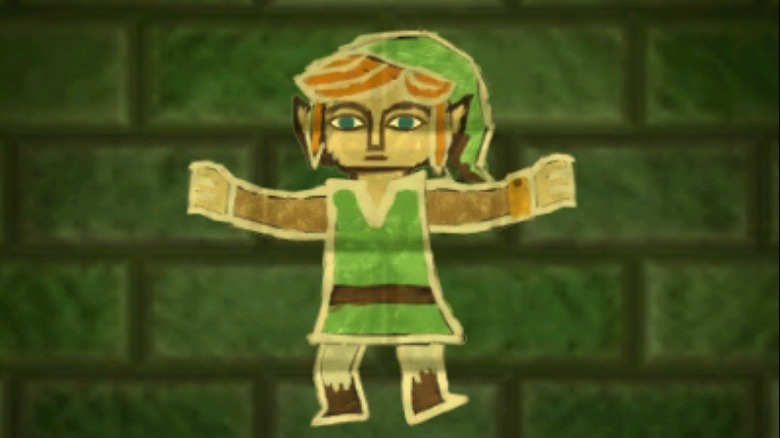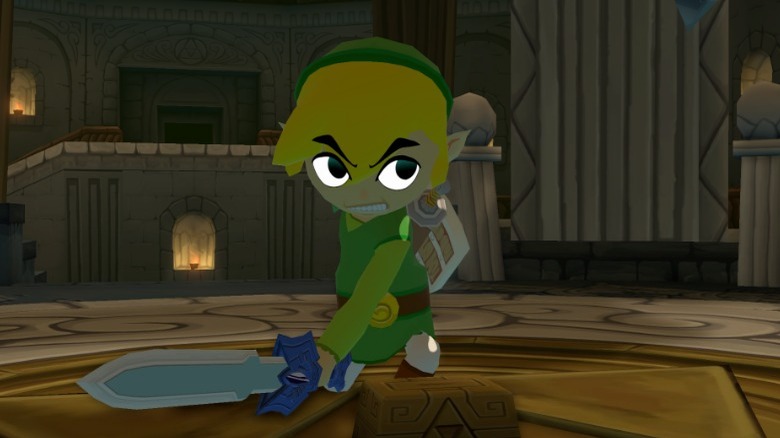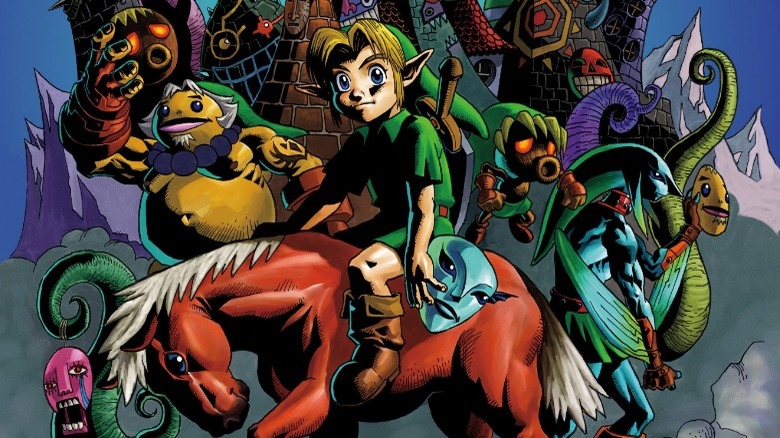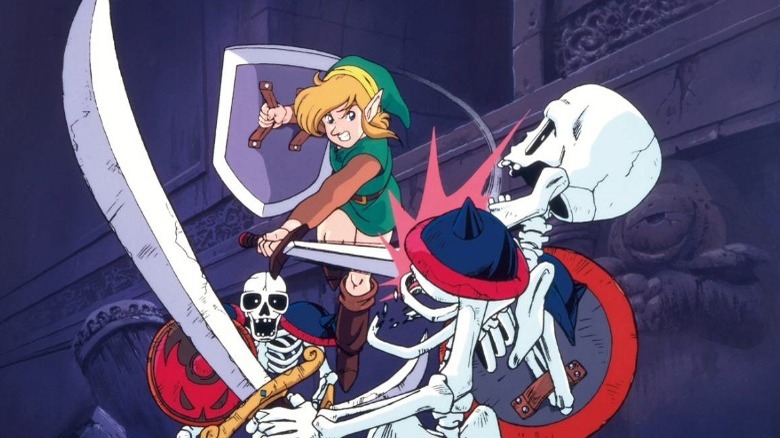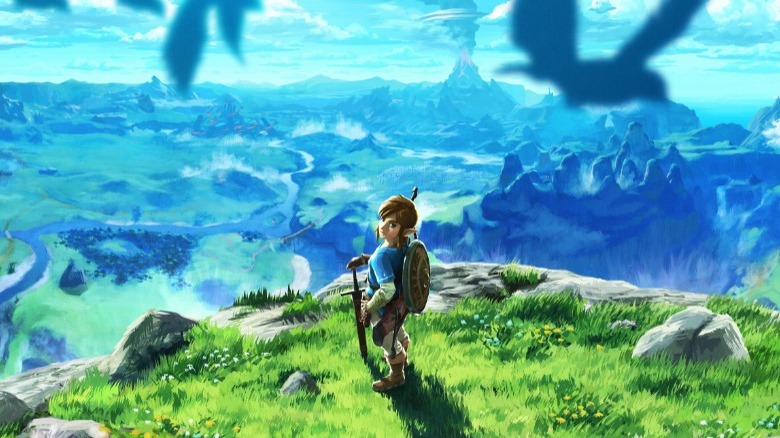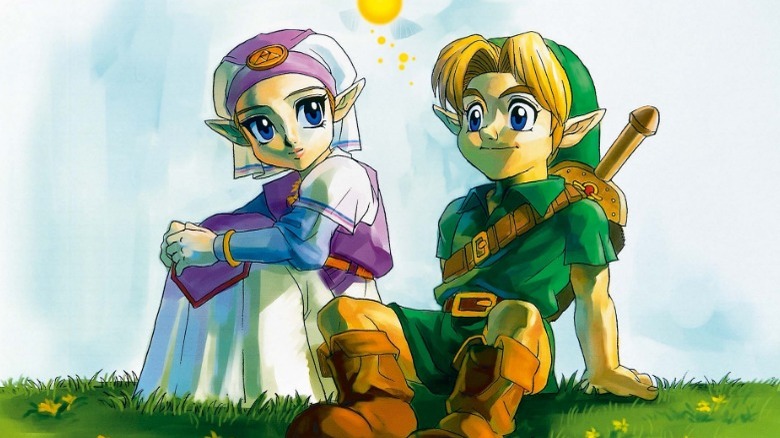Every Mainline Zelda Game Ranked From Worst To Best
The only feat in video game development more difficult or impressive than creating a great game is creating consistently great games. Many beloved franchises with sizable libraries have fallen victim to the law of averages and eventually released some stinkers. However, "The Legend of Zelda" stands in defiance of this otherwise concrete law.
For over 35 years, Nintendo has released "Zelda" game after "Zelda" game, and each one has accrued perfect or near-perfect review scores. Given this fact, one might assume there's no such thing as a bad "Legend of Zelda" title. Well, there's no such thing as a bad mainline "Zelda" game (the Philips CD-I games are renowned for laughable quality, but they're definitely spin-offs). But even then, not all "Zelda" titles are created equal. After all, how could you identify a good game if you didn't have a slightly mediocre one to compare it with?
Each "Legend of Zelda" game has its own quirks that make it unique, as well as foibles that mar the immersion. Some flaws are inescapable, while others are drowned out by the rest of the game's quality. You could take the time to weigh all the "Zelda" titles and create a definitive list that shows how they stack up against one another, but we did that for you.
Again: This list doesn't include any spinoffs, so pretend for a moment that stuff like "Freshly-Picked Tingle's Rosy Rupeeland" doesn't exist.
17. The Legend of Zelda: Tri Force Heroes
In most "Legend of Zelda" games, Link is a solo, stalwart hero who stands alone as he delves dungeons, fights the forces of darkness, and smashes pots for cash. But what happens when Link teams up with another hero or two? The worst "Zelda" game in the franchise, "The Legend of Zelda: Tri Force Heroes," that's what.
Now just to be clear, "Tri Force Heroes" isn't a bad game; it just lacks the hallmarks of the best "Zelda" titles. The game tries something different with a campy story about a land of fashion gurus. In "Tri Force Heroes," instead of saving a kingdom from an evil wizard or giant demon pig, Link must play dress-up to rescue a princess cursed with a gaudy leotard. Most outlets, including GameSpot, felt the story tied itself in a knot trying to justify its gimmicks.
"Tri Force Heroes" relies on two features: costumes and multiplayer. Different outfits provide unique abilities, and while most reviewers liked the clothes, they weren't as forgiving with the co-op. To implement multiplayer, "Tri Force Heroes" splits the world into a patchwork of levels, forcing players to cooperate to solve puzzles. That focus on teamwork unfortunately sucks the life out of single-player mode. While solo, players have to juggle Link's soul between three otherwise-immobile dolls to trudge through areas designed for three active heroes.
When you play "The Legend of Zelda: Tri Force Heroes" with friends, the game has its moments. When played alone, it is a fashion disaster.
16. Zelda 2: The Adventure of Link
Sometimes, when developers make sequels, it seems as though they throw ideas at a wall to see what sticks. This slapdash design can create surprising results, even if they aren't universally beloved.
After Nintendo found success with the original "Legend of Zelda," the company tried something different for "Zelda 2: The Adventure of Link." Instead of doubling down on the exploration and brainteasers audiences loved, the company made a U-turn into side-scrolling territory that replaced puzzles with combat and RPG leveling. Many gamers hate "Zelda 2" for these changes, but under a microscope, the game doesn't deserve that reputation. Outlets such as GoombaStomp have praised the combat in "Zelda 2," as it rewards patience and precision.
In truth, the biggest problem with "Zelda 2" is its difficulty. The game can be crushingly unfair and it only gives players a limited number of lives. Anyone who loses all their lives has to start over from scratch and traverse the same areas again until they finally triumph through sheer tenacity — or give up and play something else.
Since "Zelda 2: The Adventure of Link" changed virtually everything audiences liked about the first "Zelda" game, players weren't too accepting. However, "Zelda 2" is better than many gamers make it out to be — ironically, the problems with "Zelda 2" make it special. Sometimes it's the imperfections that makes things beautiful.
15. The Legend of Zelda
You can't expect perfection when starting out. No matter how good an initial game is, it will be undercooked in some areas. Regardless, a first attempt usually deserves to be witnessed, not because it is a great product but because it is a proof of concept that formed the groundwork of future endeavors.
As pointed out by GameSkinny, the first "Legend of Zelda" game introduced many of the basic mechanics that are synonymous with the "Zelda" franchise. The game emphasizes exploration and lets players go anywhere at any time, but it might be too open-ended. Critics have pointed out that "The Legend of Zelda" offers little in the way of direction and clues, and what few clues it provides are absurdly cryptic.
Sure, "The Legend of Zelda" makes every discovery feel like an accomplishment, but that's because it hides secrets without any indication they exist. You won't know if a bush covers a secret passage unless you channel your inner pyromaniac and burn everything in sight — or read a guide. Many internet personalities, such as SomecallmeJohnny, recommend playing "The Legend of Zelda" with a walkthrough on hand. Otherwise, you might overlook essential secrets and items, including the only weapon that can kill the final boss.
"The Legend of Zelda" is the kind of game you should play for the experience and to see how much the franchise has grown. If you want to check out the game's story, though, just read its instruction manual.
14. The Legend of Zelda: Phantom Hourglass
Nintendo has led the charge when it comes to alternative control schemes. The company tried to popularize motion controls with the Wii and Wii U, and it emphasized touchscreens with the DS and 3DS. As such, Nintendo has used its first-party games to champion these button-mashing alternatives to varying degrees of success.
With "The Legend of Zelda: Phantom Hourglass," Nintendo hoped to kill several kargaroks with one stone. The game is a direct sequel to "The Legend of Zelda: Wind Waker" and an effort at introducing purely touchscreen-based controls. According to IGN, the touchscreen only partially works, since input interpretations are left to the whims of the DS. Want to roll instead of attack? That's apparently up to the console. While this control scheme allows for unique mechanics like tracing the trajectory for a boomerang, it strips puzzles down to "follow the instructions to do x in y order."
While touchscreen control fumbles can be forgiven, critics have found the cardinal sin of "Phantom Hourglass," the Temple of the Ocean King, to be indefensible. Players have to revisit the temple numerous times and retread the same areas each visit, all while fighting against a timer. To pour salt in the repetitive wound, the game's other dungeons are hamstrung to make room for the temple.
Some say insanity is doing the same thing over and over again and expecting different results. Ergo, the Temple of the Ocean King is the video game manifestation of insanity, which drags down the enjoyability of "The Legend of Zelda: Phantom Hourglass."
13. The Legend of Zelda: Four Swords Adventures
Second time isn't always the charm. Sometimes, a company gets things right the first time — or at least does it better.
Before "The Legend of Zelda: Tri Force Heroes," there was "The Legend of Zelda: Four Swords Adventures." Thanks to the magic of link cables, players can gather around a Gamecube and witness action that seamlessly transfers from the TV to Game Boy Advance screens. This system allows players to wander off without breaking the flow of gameplay while also communicating to solve puzzles cooperatively. However, "Four Swords Adventures" has one more devious trick up its sleeve: Participants are free to backstab each other for pleasure and profit. Betraying your fellow Links is half the fun.
Unfortunately, while "Four Swords Adventures" is the best multiplayer "Zelda" experience out there, critics have found that it comes at the cost of a decent solo experience. When playing alone, the turncoat chaos that gives "Four Swords Adventures" its charm is absent. Plus, regardless of mode, each "Four Swords Adventures" level is insular. Items are restricted to specific areas, so the game doesn't feature any building sense of power or progression, let alone a compelling and overarching story.
"The Legend of Zelda: Four Swords Adventures" is at its best when four players are huddled around a TV, cooperating with each other one second and throwing allies off cliffs the next. Of course, unless each participant packs their own GBA and link cable, that's not happening — and the game's single-player experience is no replacement.
12. The Legend of Zelda: Spirit Tracks
When you think of "Legend of Zelda" games, high fantasy concepts such as prophecies and fairies come to mind. The franchise has spurts of technology such as the hookshot, but these usually fall into the realm of fantasy tech. "The Legend of Zelda: Spirit Tracks" asks the question, "What if Hyrule had trains?" The answer is better than you might think.
"Spirit Tracks" is a follow-up to "Phantom Hourglass" that takes place in the same timeline, uses the same art style, and copies the touchscreen control scheme. However, "Spirit Tracks" is superior to its predecessor.
The biggest improvement in "Spirit Tracks" is the Spirit Tower. On paper, it sounds like the Temple of the Ocean King, but the tower's levels are more diverse, and players don't have to retread old ground each time they enter. Plus, the tower replaces the time limit with Zelda's spirit. She can possess various Phantom enemies with different abilities, and since the story is about retrieving Zelda's body, the game gives her far more agency than most "Zelda" entries.
However, "Spirit Tracks" isn't as well-oiled as other titles. The game falls into the unfortunate pitfall of forcing players to backtrack. In one particular instance, "Spirit Tracks" roadblocks progress until players fulfill a quest that takes them all over the map for arbitrary reasons. Still, "The Legend of Zelda: Spirit Tracks" essentially put touchscreen-controlled "Zelda" games on the right track.
11. The Legend of Zelda: Skyward Sword
Many gamers would love to pretend they have the sword skills of fictional heroes, so it was inevitable a studio would develop a game with screen-accurate motion-controlled sword swings. Unfortunately, as "The Legend of Zelda: Skyward Sword" demonstrates, that kind of attention to detail can result in tunnel vision.
"Skyward Sword" leans heavily on motion controls to great effect. Sites like Eurogamer and Den of Geek praised how the Wii translates hand motions into on-screen sword movements, as well as how the game links this mechanic to combat. Enemies easily parry errant and sloppy attacks, transforming each duel into a puzzle. "Skyward Sword" doesn't slouch on presentation, either. Stellar graphics, along with the characterizations of Link and Zelda, as well as newcomer Groose, elevate the game's origin story narrative.
While "Skyward Sword" compliments its swordplay with fantastic dungeons and bosses (audiences have particularly praised the Ancient Cistern and Koloktos), the same can't be said for general progression. "Skyward Sword" is one of the most linear entries in the franchise and forces egregious amounts of backtracking. Moreover, Link's companion Fi is a sore spot among many gamers. She is supposed to be an emotionless AI character that lives in a sword (don't ask), and that's exactly how she comes across — in the most aggravating way possible.
"The Legend of Zelda: Skyward Sword" soars above the clouds when it focuses on swordplay action, but whenever the game tries to justify its story length, it comes crashing down to Earth.
10. The Legend of Zelda: The Minish Cap
To stand out from the crowd, you need to bring something unique to the table. If you only iterate what has come before without taking risks, don't be surprised if you are overlooked.
"The Legend of Zelda: The Minish Cap" is a marriage of "Zelda" new and old. The game plays like old-school top-down "Zelda" titles, but it features the presentation and art style of the then-recent "Wind Waker." While "Minish Cap" rethinks dungeon items by finding more uses for them, the game's main addition is the ability to shrink. As noted by VentureBeat, this skill powers many of the game's puzzles and boss fights.
Link can become ant-sized to explore otherwise inaccessible nooks and open new paths, and many boss battles cleverly transform classically weak "Zelda" monsters into daunting challenges. "Minish Cap' also breathes new life into NPCs with Kinstone, which offers new reasons to talk to everyone. You never know who is willing to part with a Heart Container if Link sports a matching medallion.
However, despite its unique features, "Minish Cap" is rarely remembered. GameXplain theorized that by combining the identities of disparate "Zelda" styles (and not treating the shrinking ability as a core mechanic), the game lacks focus and an identity to call its own. In the end, "The Legend of Zelda: The Minish Cap" is a pretty good game that tries to play it safe and ultimately sells itself short.
9. The Legend of Zelda: Link's Awakening
Nintendo cornered the handheld gaming market fairly early with the Game Boy and its library of quality, pocket-sized titles. Even though the Game Boy doesn't have the specs to take on Nintendo's house-bound consoles, many of its games, including "The Legend of Zelda: Link's Awakening," punch above their weight class.
"Link's Awakening" should feel similar to anyone who played "A Link to the Past." More importantly, outlets like Nintendo Life claim the handheld title manages to feel like a continuation of "A Link to the Past" in a good way. The main loop of entering dungeons, finding items, and defeating bosses is intact, and the story helps the game feel bigger than it actually is.
While most "Zelda" games have clear-cut heroes and villains, "Link's Awakening" delivers a morally-gray twist partway through. Link's main mission is to leave Koholint Island by waking the Wind Fish, but Koholint is the Wind Fish's dream. That means when it wakes up, the island and its inhabitants will fade away. The game never truly capitalizes on this concept, but the knowledge sticks in gamers' minds.
However, for all its strengths, "Link's Awakening" is restricted by platform hardware. The Game Boy only has two buttons to work with, which results in a ton of item-swapping to solve basic puzzles. This becomes especially tedious in later dungeons. Even so, "The Legend of Zelda: Link's Awakening" provides an adventure far greater than the scale of its platform.
8. The Legend of Zelda: Oracle of Seasons/Ages
How do you follow up a "Zelda" game on the Game Boy? By making two "Zelda" titles with similar names and link functionality.
Critics have noted that the mini-series of "Oracle of Seasons" and "Oracle of Ages" copies and improves on the framework of "Link's Awakening." The titles use the same gameplay loop, but they speed up inventory management with seeds and rings. Instead of, say, equipping the Pegasus Boots and the Roc's Feather to jump over large gaps, then reequipping the sword to fight enemies, Link can equip the feather and the sword and eat a Pegasus Seed for a speed boost to clear the hole. Quick and efficient.
Given the titles' names, you might assume "Oracle of Seasons" and "Oracle of Ages" have a "Pokemon Red" and "Blue" relationship — not quite. "Seasons" and "Ages" are two distinct games with different visions. "Seasons" provides a combat-heavy experience, while "Ages" goes all in on the puzzles. Moreover, each game sports a unique story and different gimmick item that lets players think in the fourth dimension. The only major downside is that if you want the full "Oracle" experience, you need to buy both games, complete one, and enter a code into the other game.
While Nintendo hasn't tried a similar double-dipping release strategy for "Zelda" games since, "Oracle of Seasons" and "Oracle of Ages" are still worthwhile games if you can pick up one or both.
7. The Legend of Zelda: Twilight Princess
Once upon a time, the video game industry was obsessed with creating dark and mature games that exuded a gritty and realistic tone. The "Legend of Zelda" franchise weathered this storm rather well, but not without a few marks.
"The Legend of Zelda: Twilight Princess" is the only mainline "Zelda" game to earn a "T" rating. The title's target demographic is gamers who grew up with "Ocarina of Time" since, according to IGN, "Twilight Princess" is a "spiritual sequel." Luckily, "Twilight Princess" is far from a rehash. The game features a larger world and longer story, as well as new abilities in the form of sword techniques and the power to turn into a wolf. However, the main draw of "Twilight Princess" is its story. Much like its graphics, the game's narrative is dark, and many critics agree that Link's companion Midna is the morally grey, snarky heart of the story.
Unfortunately, the strengths of "Twilight Princess" also weigh it down. The game's graphics rely on bloom to a blinding degree, and "Twilight Princess" also forces players to plod through a lengthy introductory tutorial section. Furthermore, the title's newcomer villain, Zant, is cast aside for yet another final battle with Ganondorf.
Still, "The Legend of Zelda: Twilight Princess" is fondly remembered for its unique flavor and flaws. After all, it's not every day a world full of fairies and fish people tries its hand at mature storytelling.
6. The Legend of Zelda: A Link Between Worlds
You don't always have to reinvent the wheel to breathe new life into a franchise.
While many "Zelda" games crib from older titles and look the part, "The Legend of Zelda: A Link Between Worlds" feels unique, despite wearing its inspiration like a tunic. While the game intentionally resembles "A Link to the Past," critics feel that "A Link Between Worlds" stands out via a novel item management system. Instead of hiding bows and magic rods in dungeons, players rent most items from the merchant Ravio. These gadgets are powered by a regenerating stamina meter, rather than limited pickups or mana. This freedom, in addition to Link's new ability to transform into a mobile painting, opens up the world and dungeon design. Players can tackle dungeons in any order, and puzzles are designed with multiple items and solutions in mind.
Ironically, this itemization approach slightly hamstrings "A Link Between Worlds." Whether players find the game easy or difficult, death will eventually claim Link, and when that occurs, Ravio will reclaim his rented goods. Whenever players die, they have to trek back to Ravio and rent items again. Players can also grind for rupees to buy items outright, whichever is more future-proof.
"The Legend of Zelda: A Link Between Worlds" isn't just a link to past "Zelda" games, it also potentially provides a blueprint for future ones.
5. The Legend of Zelda: Wind Waker
Great graphical fidelity can make a video game look good for a time, but a great art style makes a game look timeless. To see this rule in action, search no further than "The Legend of Zelda: Wind Waker."
While "Wind Waker" didn't impress audiences when it was announced, the game's unique, cartoony style eventually won them over. IGN once declared that "Wind Waker" to be "the most beautiful cel-shaded videogame," and that claim isn't without merit. Of course, the game isn't just a pretty moving painting. The narrative and characters of "Wind Waker" are as charming as the graphics, and its soundscape and music library are positively reviewed to this day. Songs such as "Dragon Roost Island" and the "Molgera Battle" theme constantly earworm their way into audience favorite lists.
However, the game isn't all smooth sailing. Many critics claim "Wind Waker" is too easy, thanks in part to contextual combat actions that let Link flip and roll around the battlefield. Plus, since the game world is mostly vast ocean, traveling primarily consists of sailing plain swaths of water with the occasional island distraction. But, those complaints pale in comparison to the endgame in which players have to dredge for eight Triforce pieces — and shell out a small fortune to decode maps necessary for this treasure hunt.
"The Legend of Zelda: Wind Waker" is a beloved classic with a few flaws that are quickly washed away. Plus, Zelda herself gets to participate in the final fight, which is a step up from her usual role.
4. The Legend of Zelda: Majora's Mask
When a video game studio develops the follow-up to one of the most critically acclaimed video games ever, the heat is on to meet audience expectations for a bigger, better sequel. But is it really a big deal when the result isn't what gamers expected?
"The Legend of Zelda: Majora's Mask" was, for its time, one of Nintendo's most ambitious titles. The game was initially designed for the 64DD (via IGN), but when that Nintendo 64 add-on flopped, Nintendo scaled back its ambitions and hardware specs. Even with the downgrade, "Majora's Mask" is still technically impressive. The title's draw distance, lighting, and textures surpass other Nintendo 64 games and accentuate the tone. Unlike most "Zelda" games, "Majora's Mask" builds an unsettling, moody world threatened by an angry moon and rife with themes of denial and depression.
However, the most lauded feature of "Majora's Mask" is its time limit. Players only have three days (54 minutes of real time) to save the world. Players need to budget their time between the main quest and side missions that revolve around NPCs. Also, Link can only reclaim lost time by turning back the clock. This technique might save the game, but it also robs Link of items such as rupees and bombs, as well as uncompleted side quest progress.
"The Legend of Zelda: Majora's Mask" isn't quite perfect, as its lone major flaw is dungeons. The game only sports four, and one, the Great Bay Temple, is frequently counted among the worst in the franchise.
3. The Legend of Zelda: A Link to the Past
After "Zelda 2: The Adventure of Link" didn't impress audiences, the company went back to the drawing board and brainstormed a game that focused on what gamers praised in the original. The result is the definitive 2D adventure experience.
While "The Legend of Zelda" created the skeleton of the franchise's formula, "The Legend of Zelda: A Link to the Past" fleshed it out. The game essentially invented, as IGN put it, the "overworld exploration, item acquisition, and storyline progression" gameplay loop the series is known for. Then again, the first "Zelda" game doesn't really have much a story to speak of, so "A Link to the Past" also shoved the franchise headfirst into the world of dense storytelling.
Since "A Link to the Past" was Nintendo's first "Zelda" title on the Super Nintendo, the game demonstrates what extra console horsepower and extra controller buttons can do for the franchise. Moreover, not only does "A Link to the Past" look and handle beautifully, it maintains a sufficient pace throughout, and the game doesn't railroad players down a linear path. Also, fans can thank "A Link to the Past" for introducing franchise staples such as alternate worlds and the iconic Dead Man's Volley.
Most gamers are hard-pressed to find any obvious flaws with "The Legend of Zelda: A Link to the Past." The closest the game gets to one is that it doesn't tickle the exploration and nostalgia bones quite as well as some other "Zelda" games.
2. The Legend of Zelda: Breath of the Wild
The first "Legend of Zelda" title emphasized exploration at the cost of guidance, and subsequent "Zelda" games have overcompensated to ease players into the adventure. "The Legend of Zelda: Breath of the Wild" is a compromise that nudges gamers in the right direction while rekindling the joy of discovery.
"Breath of the Wild" focuses on the journey, not the destination. Critics across the internet, from Eurogamer to IGN, have praised the game and its vast open world. Virtually every nook and cranny hides new secrets, and many puzzles have multiple solutions. Players are encouraged to travel off the beaten path to see what is in store, or at least they would if "Breath of the Wild" had a beaten path. The game's world is organically crafted, and the endorphin rush that comes with discovering new areas, overcoming trials, and cooking magical meals can be overpowering.
However, while many gamers consider "Breath of the Wild" a breath of fresh air, the game sports a few notable flaws. For example, enemy difficulty is tied to color. Instead of facing different monsters that require unique tactics, players encounter blue, black, and gold-skinned variants that take more arrows to the face. And, of course, "Breath of the Wild" is notorious for its fragile weapons that sporadically (but consistently) burst into clouds of metal shavings.
"The Legend of Zelda: Breath of the Wild" is not so much a game as it is an experience. It's not perfect, but the best journeys thrive on victories as much as failures.
1. The Legend of Zelda: Ocarina of Time
The mark of a good video game isn't just its quality, but also its legacy. Was there ever any doubt "The Legend of Zelda: Ocarina of Time" wouldn't nab the top spot?
No matter how you slice it, "Ocarina of Time" is the definitive 3D "Zelda" title. Outlets like IGN have attributed part of the game's success to translating the classic "Zelda" formula to 3D, not to mention improving it. The Nintendo 64's controller opened up so much button real estate, making item usage a breeze with its four C buttons. However, the biggest control game changer is the Z button, which lets players lock onto enemies and gel with the context-sensitive A button to add a new dimension to combat.
The true beauty of "Ocarina of Time" lies deep within its presentation. The N64's graphical power elevates the game's atmosphere above previous "Zelda" titles, and while the story is fairly standard, many critics claim the characters make up for it. Ganondorf, for instance, left such an impact that he is recognized as a king among video game villainy. Moreover, the game's music is so catchy and iconic that it has become entrenched in the pop culture zeitgeist. Nintendo loves to reference "Ocarina of Time" tunes, sometimes cleverly sneaking them into other games.
Because of the quality and history of "The Legend of Zelda: Ocarina of Time," it is, beyond a shadow of a doubt, the best "Zelda" game. The only objective problem with it game is its Water Temple. For some reason, the franchise just has trouble with water-themed dungeons.

